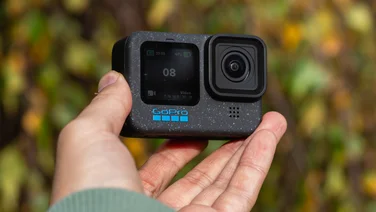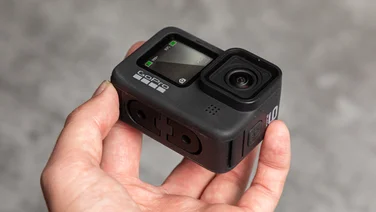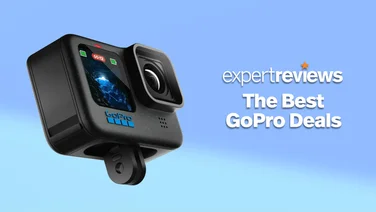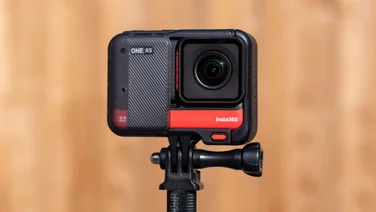To help us provide you with free impartial advice, we may earn a commission if you buy through links on our site. Learn more



















- Excellent magnetic modular design
- Fantastic image stabilisation
- Intuitive controls
- Overheats indoors
- Integrated batteries
- Pricey
Breaking free of the GoPro-clone mould, the DJI Action 2 offers a fresh new take on what an action camera can be. Succeeding the original Osmo Action, the Action 2 is smaller, lighter, magnetic and fully modular.
This pocket-sized camera unit can be used on its own or in combination with one of two expansion modules and is compatible with a range of new magnetic mounts. It’s no slouch in the spec-department either, offering 4K recording at up to 120fps and 240fps in full HD, as well as RockSteady 2.0 and HorizonSteady image stabilisation.
With premium features and a price to match, the DJI Action 2 is clearly positioned to rival GoPro’s flagship Hero 10 Black but with integrated batteries and a tendency to overheat it falls short of the mark.
DJI Action 2 review: What you need to know
More than two years since the launch of the original Osmo Action, the Action 2 starts fresh with an all-new and unique design. DJI forgoes the soap-bar shape and plastic shell of its predecessor, instead opting for an all-aluminium case with a clip-together modular design.



















At its heart sits a 1/1.7in CMOS sensor which has been paired with an ultra-wide 155-degree f/2.8 lens. The core unit can be used fully standalone or you can combine it with an accessory module. Two additional modules are available at launch: the front-facing touchscreen module that we’re looking at here and an extended-battery module. These attach to the camera via magnets and are secured in place via a pair of quick-release clips.
The DJI Action 2 packs in top-flight video specifications with 4K and 2.7K recording available at up to 120fps, and up to 240fps at 1080p. There’s also 4x slow motion in 4K and up to 8x slow motion in full HD, dedicated modes for timelapses and hyperlapses, and a social media-friendly Quick Clip mode that shoots short 15-second videos.



















The camera also benefits from DJI’s latest electronic stabilisation tech. RockSteady 2.0 is available at all resolutions, while video shot at 2.7K and below can take advantage of horizon-leveling functionality courtesy of HorizonSteady.
As with all of DJI’s recent camera releases, the Action 2 can be paired with the DJI Mimo smartphone app for remote camera control and video playback, as well as mobile editing and uploading.
DJI Action 2 review: Price and competition
The DJI Action 2 is currently available as part of two bundles: the £349 Power Combo, which includes a camera unit and extended battery module or the Dual-Screen Combo, which I’m looking at here. This includes the camera unit and a front-facing touchscreen module. Both bundles come with a magnetic lanyard, magnetic action camera mount adapter, adhesive ball-joint adapter and a USB-C power cable.
As far as rivals are concerned, the GoPro Hero10 Black is an obvious competitor. Right now the Hero10 is the only other action camera to match the Action 2’s 4K120 recording capabilities and actually takes things a step further, supporting 5.3K video at up to 60fps. While the Hero10’s list price is a touch higher at £480, if you order from GoPro directly it’s available with a one-year GoPro subscription, which gives you cloud storage, a discount on GoPro accessories and full-camera replacement in case of damage for £380.
The Insta360 One R uses a similar modular design but also allows you to switch out camera units. The standard 4K camera can be picked up for £285, while the Twin Edition, which comes with 4K and 360 camera units, is available for £440.
Insta360’s £295 Go 2 camera is also worth considering. While it doesn’t pack flagship-level framerates, this small, lightweight cam can go places larger models can’t and, thanks to its magnetic mounting design, offers some of the Action 2’s versatility at a much lower price.
DJI Action 2 review: Features and design
The Action 2’s main camera unit weighs 56g and measures 39 x 39mm across the face with a depth of 22.3mm. Despite its lightweight design, thanks to its aluminium frame it still feels solid in the hand.



















A glass housing takes up most of the front of the camera, behind which sits the 155-degree ultra-wide lens along with a dedicated colour temperature sensor, and is flanked by small holes for the microphone and LED status light. The back of the camera is dominated by a 1.7in OLED touchscreen display, while there’s a single physical button on top of the unit and an expansion port across the base. The bottom of the camera is magnetised for quick mounting to metallic objects and there are clip-on points for securely attaching modules and mounts.
The camera unit has its own battery and 32GB (22GB of usable) of internal storage, allowing it to be used as a standalone device. However, since the main camera has no charging port, microSD card reader or speaker built-in, the front touchscreen module needs to be kept close by.
The front touchscreen module attaches to the main camera unit with a satisfying click by lining up the clips and letting the magnets do the rest. At 39 x 41.6mm across the face and 24.6mm deep it’s slightly larger than the camera unit and adds an extra 64g of weight. As well as adding a second, front-facing display, this module houses the Action 2’s microSD card reader, USB type-C charging port, a trio of additional microphones (one on each side and one on the rear) and an extended battery. Like the camera unit, the touchscreen module is magnetic across its base, allowing for quick mounting and also has clip-on points for pairing with more secure mounts.



















While the front touchscreen module (and the Power Combo’s power module) expand the Action 2’s functionality, this comes at the expense of weather sealing. The main camera unit is waterproof down to 10m straight out of the box but the exposed ports on the expansion modules mean you have to use a waterproof case to get the same degree of protection.
DJI Action 2 review: Performance
In use, the Action 2 does a great job of judging exposures, retaining highlights while maintaining enough dynamic range to hold onto plenty of detail in the shadows. Transitions between bright and dark scenes are nice and smooth and the auto white balance – likely thanks to the Action 2’s dedicated colour temperature sensor – is very reliable.



















In good light, footage is sharp, richly detailed and free of distracting artifacts. Using the standard colour profile videos appear natural with just a little extra pop, while a D-Cinelike profile is available should you want to grade the footage yourself. Although the Action 2 includes a large 1/1.7in sensor and bright f/2.8 aperture, like most action cameras it still suffers in low light and grain can quickly start to muddy the details if you’re not careful.
Video of DJI Action 2 | 4K Action Camera Test Footage
While I’m yet to try out this year’s GoPro flagship, I can say that DJI’s RockSteady 2.0 is right up there with the best stabilisation tech I’ve tested. Jerky and erratic movements are nicely stabilised and footage shot while walking and running is gimbal-smooth.
Taking things to the next level, DJI’s HorizonSteady keeps footage level too. This feature is incredibly effective and allows you to rotate the camera through a full 360 degrees while still maintaining a perfectly level shot. HorizonSteady is limited to 2.7K resolutions and below, and as the stabilisation is applied digitally there is a slight crop but, given the Action 2’s ultra-wide 155-degree field of view, this isn’t too much of a penalty.
Video of DJI Action 2 | RockSteady 2.0 & HorizonSteady Stabilisation Test Footage
Speaking of ultra-wide, that 155-degree field of view is perfect for squeezing just about everything in front of you into the frame. As you might expect, there’s a tonne of distortion, so users will likely stick with the wide or wide dewarp views most of the time but it’s certainly a nice creative tool to have.



















The magnetic mounting system is very practical, allowing for quick-mounting to pretty much anything metallic and the included magnetic lanyard allows you to do away with bulky chest mounts. The magnets do have their limits – shake the lanyard vigorously enough and you’ll dislodge it – but for casual shooting it’s a great option to have and, of course, the clip-on adapter is always available for more extreme situations.
While the OLED screens are great for quick framing, their small size and square aspect ratio can be limiting for playback. Fortunately, DJI’s Mimo smartphone app (available for both Android and iOS) supports full camera control, playback and even mobile editing. Both the app, and the camera for that matter, are very intuitive to use and I found it very easy to get up to speed with them.
Where the Action 2 starts to come unstuck is battery life. DJI advertises that the camera unit offers up to 70 minutes of recording but this is in power reserve mode at 1080p with stabilisation turned off. Recording at 4K60 I managed to eke out 18mins 40 secs before the camera unit was drained and adding the front touchscreen extended this to a more respectable 62 minutes. As the batteries are built into the modules, you’re unable to swap them out on the fly like you can with a GoPro, but you can top them up using a USB power bank.
Overheating is also a problem. Indoors, I found that my unit would overheat and shut down after only seven minutes of recording at 4K60, and just shy of 15 minutes while recording at 2.7K60. Performance is, however, very dependent on airflow, as outside while running I was able to record in 4K until I ran the camera unit’s battery flat.



















There is an option to raise the overheating threshold buried in the settings menu but due to regulations, this option is disabled on UK and EU units. Overheating issues are certainly not exclusive to the DJI Action 2 but, depending on how you plan to use the camera, it could impose some serious limitations.
The onboard audio recording is also nothing particularly special and can become a little muddy and compressed in busy environments. Adding the front touchscreen module helps a bit but audio remains mediocre.
DJI Action 2 review: Verdict
The DJI Action 2 is an innovative, versatile and fun little action camera. It’s easy to use, the stabilisation is fantastic and, whether used on its own, or paired with DJI’s Mimo app, it’s capable of producing excellent results.
If it was aimed primarily at casual users and priced accordingly I’d say it makes a solid case for being one of the best options available right now. At £455 for the Dual-Screen Combo, however, it’s firmly an enthusiast product and, with middling battery life, non-weather sealed modules and serious overheating issues it doesn’t perform at that level.
The battery life and overheating issues may very well be addressed by future firmware updates and the price will likely come down over time but, as it is, it just feels like it falls a little short of the mark.










